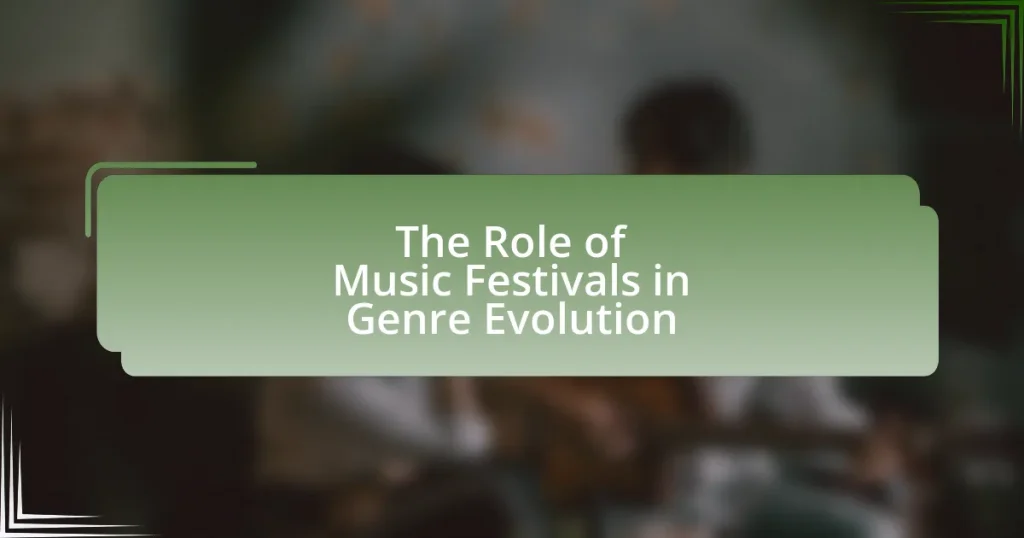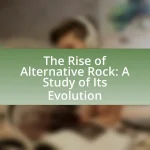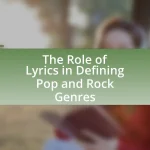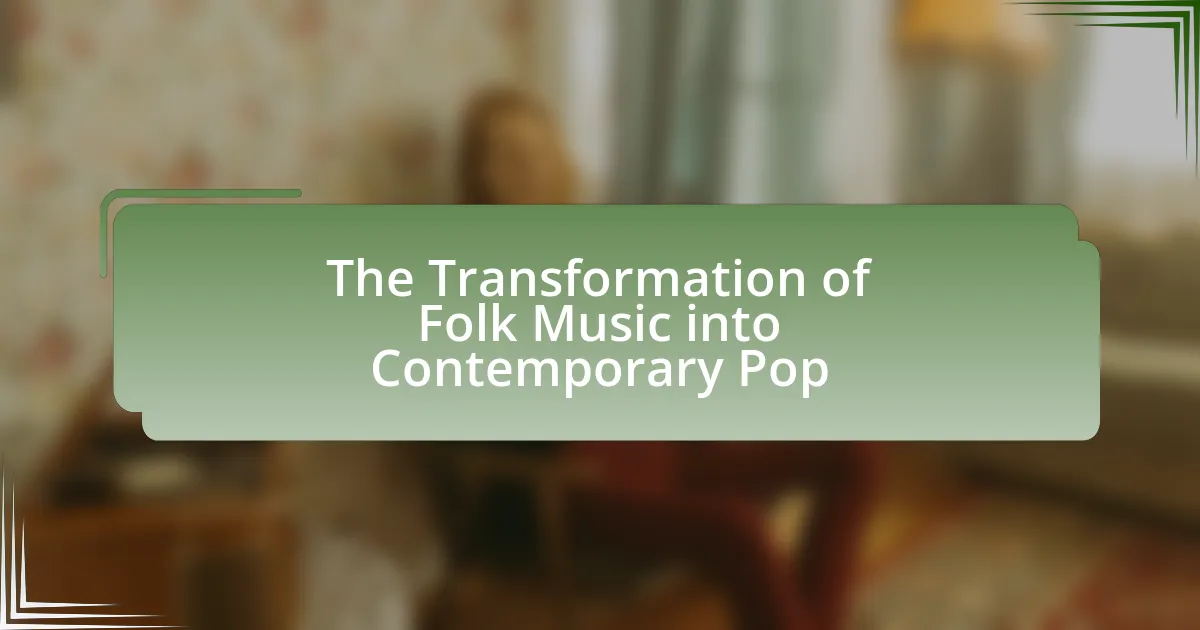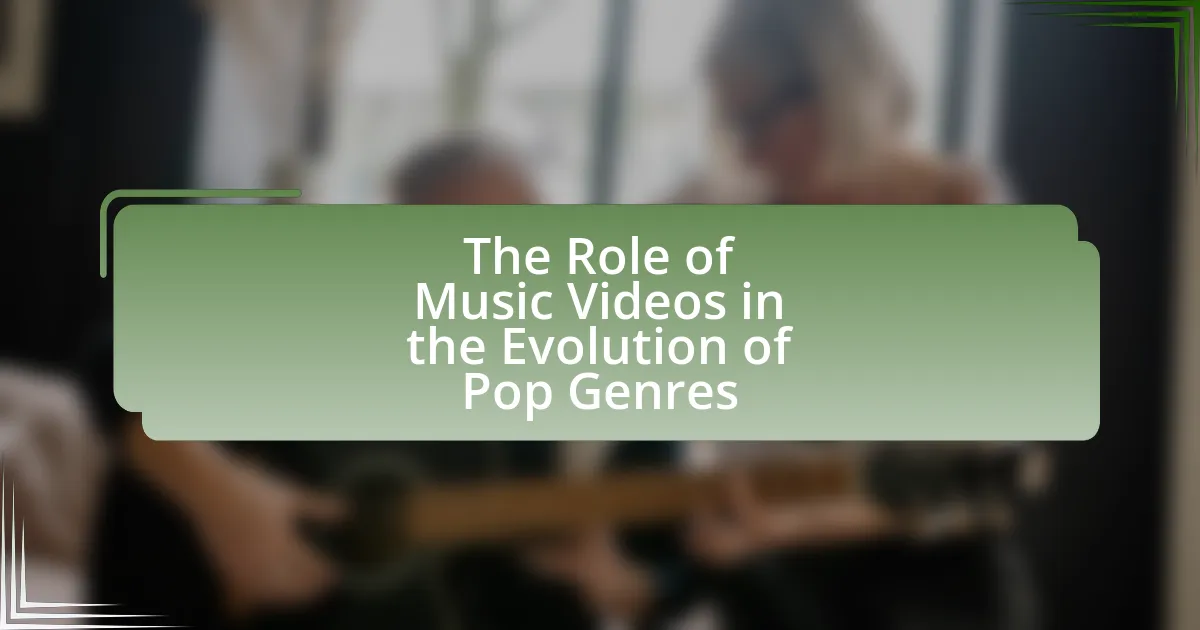Music festivals serve as pivotal platforms for the evolution of musical genres by facilitating diverse artistic expressions and collaborations. They encourage genre blending and innovation, as seen in historical examples like Woodstock and contemporary events such as Coachella and Glastonbury. These festivals not only introduce audiences to emerging genres but also significantly impact artist exposure and career growth, while fostering economic benefits for local music scenes. Key factors driving genre evolution at festivals include audience diversity, technological advancements, and collaborative opportunities among artists, despite challenges posed by commercial interests and audience expectations.
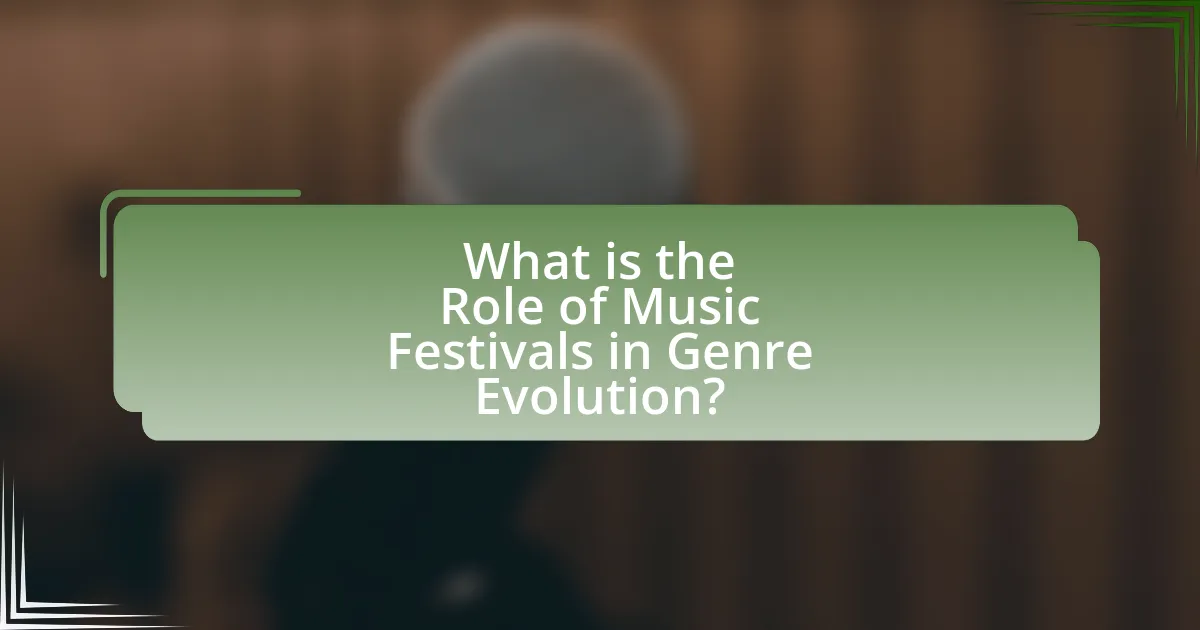
What is the Role of Music Festivals in Genre Evolution?
Music festivals play a crucial role in genre evolution by serving as platforms for diverse musical expressions and collaborations. These events facilitate the blending of genres, allowing artists to experiment and innovate, which can lead to the emergence of new styles. For instance, the Coachella Valley Music and Arts Festival has historically showcased a mix of genres, from rock to hip-hop, influencing trends and encouraging cross-genre collaborations. Additionally, festivals often introduce audiences to niche genres, expanding their reach and popularity, as seen with the rise of electronic dance music (EDM) through events like Tomorrowland. This exposure can significantly impact the music industry, shaping listener preferences and driving the evolution of genres over time.
How do music festivals influence the development of musical genres?
Music festivals significantly influence the development of musical genres by providing a platform for diverse artists to showcase their work, facilitating genre blending and innovation. These events often feature a wide range of musical styles, allowing artists from different backgrounds to collaborate and experiment, which can lead to the emergence of new subgenres. For instance, the Woodstock Festival in 1969 played a crucial role in popularizing rock music and fostering the fusion of rock with folk and blues, ultimately shaping the sound of the era. Additionally, festivals like Coachella and Glastonbury have been instrumental in promoting electronic dance music and indie rock, respectively, by introducing audiences to new sounds and trends. This exposure not only helps artists gain recognition but also influences listeners’ musical tastes, driving the evolution of genres over time.
What historical examples illustrate genre evolution through music festivals?
The Woodstock Festival in 1969 exemplifies genre evolution through music festivals by showcasing the rise of rock and counterculture music. This festival featured artists like Jimi Hendrix and Janis Joplin, who helped popularize psychedelic rock and folk rock, influencing the music landscape significantly. Another key example is the Glastonbury Festival, which began in 1970 and has evolved to include diverse genres such as electronic, hip-hop, and world music, reflecting changing musical tastes over decades. The emergence of Coachella in the late 1990s further illustrates this evolution, as it has become a platform for indie, pop, and electronic music, highlighting the blending of genres and the introduction of new artists to mainstream audiences. These festivals not only showcase specific genres but also facilitate cross-genre collaborations, thereby driving the evolution of music styles.
How do music festivals serve as platforms for emerging genres?
Music festivals serve as platforms for emerging genres by providing exposure and performance opportunities for new artists and styles. These events attract diverse audiences, allowing lesser-known genres to reach wider demographics, which can lead to increased popularity and acceptance. For instance, festivals like Coachella and Glastonbury have featured artists from genres such as electronic dance music and indie rock, significantly contributing to their mainstream success. Additionally, the collaborative environment of festivals fosters networking among artists, promoters, and fans, further promoting genre innovation and evolution.
Why are music festivals significant in the music industry?
Music festivals are significant in the music industry because they serve as major platforms for artists to showcase their work, connect with fans, and influence genre evolution. These events attract large audiences, often exceeding tens of thousands of attendees, which provides artists with exposure and opportunities to reach new listeners. For example, festivals like Coachella and Glastonbury have historically launched the careers of numerous artists and have been pivotal in popularizing emerging genres. Additionally, music festivals foster collaboration among artists from different genres, leading to innovative sounds and cross-genre experimentation, which is essential for the evolution of music styles. The economic impact of music festivals also underscores their significance, as they generate substantial revenue for local economies and the music industry, with the global music festival market valued at over $30 billion in 2022.
What economic impacts do music festivals have on local music scenes?
Music festivals significantly boost local music scenes by increasing revenue, attracting tourism, and providing exposure for local artists. These events generate substantial economic activity; for instance, a study by the National Endowment for the Arts found that music festivals can contribute millions to local economies through ticket sales, food and beverage purchases, and hotel bookings. Additionally, festivals often feature local musicians, enhancing their visibility and opportunities for future gigs, which fosters a vibrant local music culture. This symbiotic relationship between festivals and local artists ultimately strengthens the overall music ecosystem in the area.
How do music festivals contribute to artist exposure and career growth?
Music festivals significantly enhance artist exposure and career growth by providing a platform for live performances to diverse audiences. These events attract large crowds, often exceeding tens of thousands of attendees, allowing artists to showcase their music to potential fans who may not have encountered them otherwise. For instance, festivals like Coachella and Glastonbury have historically propelled lesser-known artists into the spotlight, leading to increased streaming numbers and social media following post-performance. Additionally, participation in festivals can lead to networking opportunities with industry professionals, including record labels and promoters, which can facilitate future collaborations and bookings. According to a study by the University of Southern California, artists who perform at festivals experience a 30% increase in their overall visibility and engagement metrics within weeks of their performance.
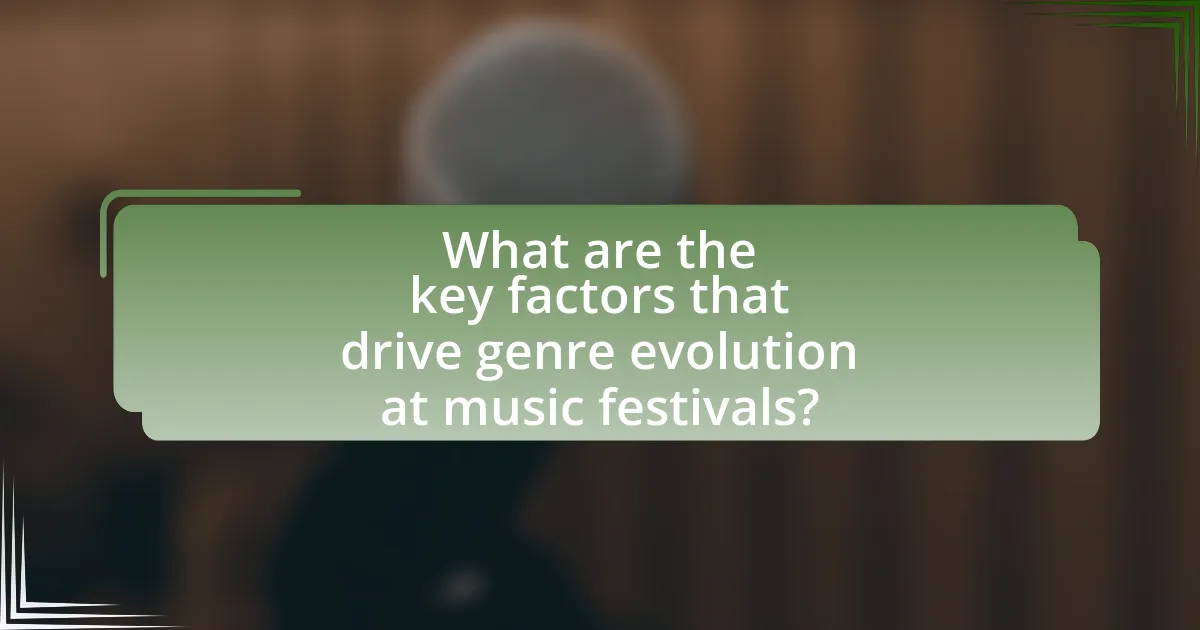
What are the key factors that drive genre evolution at music festivals?
Key factors that drive genre evolution at music festivals include audience diversity, artist collaboration, and technological advancements. Audience diversity introduces various musical tastes and influences, prompting artists to experiment and blend genres to appeal to a broader crowd. For instance, festivals like Coachella showcase a mix of genres, encouraging cross-genre collaborations that lead to new sounds. Additionally, technological advancements in music production and performance, such as digital audio workstations and live streaming, enable artists to innovate and reach wider audiences, further influencing genre evolution. Historical examples include the rise of electronic dance music (EDM) at festivals, which transformed the landscape of popular music in the 2010s, demonstrating how these factors collectively shape and evolve musical genres.
How does audience diversity affect genre evolution at festivals?
Audience diversity significantly influences genre evolution at festivals by introducing a variety of musical tastes and cultural backgrounds that shape the programming and performance styles. When festivals attract a heterogeneous audience, artists are encouraged to experiment with different genres and collaborate across styles, leading to innovative musical fusions. For instance, the emergence of genres like “world music” and “electronic dance music” can be traced back to festivals that embraced diverse audiences, allowing for cross-pollination of musical ideas. This phenomenon is supported by data showing that festivals with diverse lineups often see increased attendance and engagement, which further incentivizes artists to explore and blend genres to appeal to a broader audience.
What role does cultural exchange play in shaping musical genres at festivals?
Cultural exchange plays a crucial role in shaping musical genres at festivals by facilitating the blending of diverse musical traditions and influences. This interaction allows artists and audiences to experience and incorporate elements from various cultures, leading to the creation of hybrid genres. For instance, the emergence of world music genres often stems from festivals that showcase artists from different cultural backgrounds, such as the WOMAD festival, which promotes global music and cultural exchange. Research indicates that exposure to different musical styles at festivals can inspire artists to innovate and experiment, resulting in new sounds and genres that reflect a fusion of cultural influences.
How do festival lineups influence genre popularity and trends?
Festival lineups significantly influence genre popularity and trends by showcasing specific artists and styles, thereby shaping audience preferences. When a festival features a diverse range of genres, it exposes attendees to new music, which can lead to increased interest and consumption of those genres. For instance, the Coachella Valley Music and Arts Festival has historically highlighted emerging genres like electronic dance music, contributing to its mainstream acceptance and growth. Data from the Nielsen Music report indicates that genres prominently featured at major festivals often see a spike in streaming and sales following the events, demonstrating a direct correlation between festival lineups and genre popularity.
What technological advancements impact music festivals and genre evolution?
Technological advancements such as digital streaming, social media, and advanced sound and lighting systems significantly impact music festivals and genre evolution. Digital streaming platforms like Spotify and Apple Music allow artists to reach wider audiences, influencing genre popularity and festival lineups. Social media enables real-time engagement and marketing, shaping festival experiences and artist discovery. Additionally, advancements in sound and lighting technology enhance live performances, attracting diverse genres and creating immersive experiences that evolve musical styles. For instance, the rise of electronic dance music (EDM) at festivals like Tomorrowland is largely attributed to improved sound systems and visual effects, which have transformed audience expectations and genre dynamics.
How do streaming services and social media shape festival experiences?
Streaming services and social media significantly shape festival experiences by enhancing accessibility and engagement. Streaming platforms allow audiences to access live performances remotely, broadening the reach of festivals beyond physical attendees. For instance, Coachella has streamed its performances online, attracting millions of viewers globally, which increases the festival’s visibility and potential revenue. Social media amplifies this effect by enabling real-time sharing of experiences, allowing attendees to post updates, photos, and videos, which creates a sense of community and FOMO (fear of missing out) among followers. According to a study by Eventbrite, 62% of festival-goers share their experiences on social media, influencing others to attend future events. This interconnectedness between streaming services and social media not only enhances the festival experience for attendees but also cultivates a larger audience for the artists and the festival itself.
What innovations in sound and production enhance genre representation at festivals?
Innovations in sound and production that enhance genre representation at festivals include advanced audio technology, immersive sound systems, and real-time sound manipulation. These innovations allow for a more authentic and diverse auditory experience, enabling festival-goers to fully engage with various music genres. For instance, the use of spatial audio technology creates a three-dimensional sound environment, which can replicate the nuances of different genres more accurately. Additionally, high-fidelity sound systems, such as line array speakers, ensure that sound quality is maintained across large areas, allowing for a consistent experience regardless of the listener’s location. Furthermore, real-time sound manipulation tools enable artists to adapt their performances dynamically, incorporating elements from multiple genres and enhancing the overall representation of diverse musical styles at festivals.
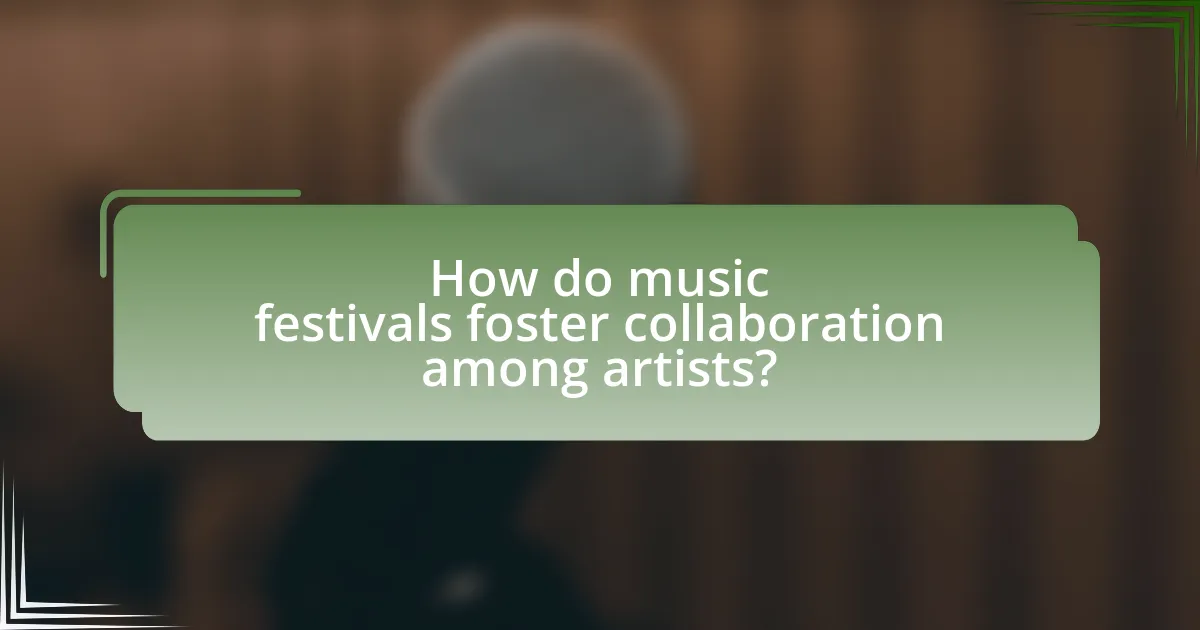
How do music festivals foster collaboration among artists?
Music festivals foster collaboration among artists by providing a shared platform for diverse musicians to perform, network, and engage in creative exchanges. These events often feature artists from various genres, encouraging cross-genre collaborations that may not occur in traditional settings. For instance, festivals like Coachella and Glastonbury have historically seen artists from different backgrounds collaborate on stage, leading to unique performances and new musical styles. This collaborative environment is further enhanced by workshops, panels, and informal jam sessions that facilitate interaction and idea sharing among artists, ultimately contributing to the evolution of music genres.
What collaborative opportunities arise from music festivals?
Music festivals create collaborative opportunities by bringing together diverse artists, industry professionals, and audiences, fostering cross-genre collaborations and networking. These events often feature artists from various musical backgrounds, encouraging them to collaborate on stage or in studio settings, which can lead to innovative genre-blending projects. For instance, the Coachella Valley Music and Arts Festival has historically showcased artists from different genres, resulting in unique performances and collaborations, such as the 2018 surprise set by Beyoncé with other artists. Additionally, music festivals provide a platform for emerging artists to connect with established musicians and industry insiders, facilitating mentorship and partnership opportunities that can enhance their careers.
How do genre-blending performances at festivals influence musical styles?
Genre-blending performances at festivals significantly influence musical styles by fostering innovation and collaboration among diverse artists. These performances create a unique environment where musicians from different genres experiment with their sounds, leading to the emergence of hybrid styles. For instance, the Coachella Valley Music and Arts Festival has showcased artists like Billie Eilish and Khalid, who blend pop, R&B, and electronic music, thereby influencing mainstream trends. Additionally, research indicates that exposure to varied musical influences at festivals encourages artists to incorporate elements from other genres into their work, as seen in the rise of genres like trap and reggaeton, which have gained popularity through cross-genre collaborations. This dynamic interaction not only reshapes individual artists’ styles but also contributes to the overall evolution of music genres in contemporary culture.
What are the benefits of cross-genre collaborations at festivals?
Cross-genre collaborations at festivals enhance creativity and broaden audience appeal. These collaborations allow artists to experiment with diverse musical styles, leading to innovative sounds that can redefine genres. For instance, the blending of hip-hop and rock at festivals has produced unique performances that attract fans from both genres, increasing attendance and engagement. Additionally, such collaborations foster a sense of community among artists and fans, promoting cultural exchange and collaboration across different musical backgrounds. This dynamic environment not only enriches the festival experience but also contributes to the evolution of music genres by encouraging artists to push boundaries and explore new artistic directions.
What challenges do music festivals face in promoting genre evolution?
Music festivals face several challenges in promoting genre evolution, primarily due to audience expectations, market segmentation, and financial constraints. Audience expectations often lean towards established genres, making it difficult for festivals to introduce and promote emerging styles. Market segmentation further complicates this, as festivals typically cater to specific demographics that may resist genre blending. Financial constraints also play a significant role; festivals may prioritize popular acts to ensure ticket sales, limiting opportunities for innovative genre experimentation. These factors collectively hinder the ability of music festivals to effectively promote and support the evolution of musical genres.
How do commercial interests affect the diversity of genres represented?
Commercial interests significantly limit the diversity of genres represented at music festivals. Organizers often prioritize popular genres that attract larger audiences and sponsorships, leading to a homogenization of the lineup. For instance, a study by the University of Southern California found that festivals predominantly feature mainstream genres like pop and electronic dance music, which are more commercially viable, while niche genres receive less representation. This trend results in fewer opportunities for emerging artists and diverse musical expressions, ultimately shaping the cultural landscape of music festivals.
What barriers exist for emerging genres at established festivals?
Emerging genres face several barriers at established festivals, primarily due to programming constraints, audience expectations, and financial limitations. Established festivals often prioritize well-known genres and artists that guarantee ticket sales, which can marginalize newer or less mainstream genres. Audience expectations also play a significant role; festival-goers may attend expecting familiar sounds, making it challenging for emerging genres to gain traction. Additionally, financial limitations can restrict the ability of festival organizers to take risks on unproven genres, as they may lack the budget to promote and support these acts effectively. These factors collectively hinder the visibility and growth of emerging genres within the festival circuit.
What are best practices for artists and organizers to enhance genre evolution at festivals?
Artists and organizers can enhance genre evolution at festivals by fostering collaboration and experimentation among diverse musical styles. By creating platforms for cross-genre collaborations, artists can blend elements from different genres, leading to innovative sounds that push the boundaries of traditional music classifications. For instance, festivals like Coachella and Glastonbury have successfully showcased artists from various genres on the same stage, encouraging unique collaborations that attract diverse audiences and stimulate genre evolution. Additionally, organizers can implement workshops and panels that focus on genre fusion, providing artists with the tools and knowledge to explore new musical territories. This approach not only enriches the festival experience but also contributes to the ongoing evolution of music genres.
